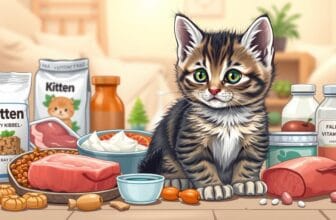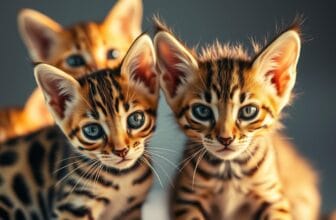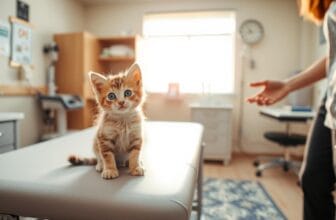
Did you know that the Turkish Angora is one of the oldest natural cat breeds, dating back centuries? These elegant felines are known for their silky, soft coats and playful personalities, making them a favorite among pet lovers.
Table of Contents
Their history is as rich as their appearance. Originating in Turkey, these cats were once considered a symbol of luxury and grace. Today, they continue to captivate families with their affectionate nature and lively demeanor.
If you’re looking for a pet that’s both beautiful and engaging, the Turkish Angora might be the perfect choice. They thrive in active households and form strong bonds with their owners. In this article, we’ll explore their history, unique traits, and care needs to help you decide if this breed is right for you.
Introduction to Angora Kittens
Originating from Turkey, the Turkish Angora is a breed with a rich history. Recognized as a distinct breed by the 17th century, these cats are known for their elegance and charm. Unlike other long-haired breeds like Persians, Turkish Angoras have a lighter, silkier coat that requires less maintenance.
These cats typically weigh between 5 to 12 pounds and have a lifespan of 12 to 18 years. They are vocal and love interacting with their human family, making them excellent companions. Their playful nature and intelligence make them a joy to have around.
One unique trait of the Turkish Angora is their fascination with water. Often called “swimming cats,” they enjoy playing in water and may even join you in the shower. This sets them apart from many other breeds.
It’s important to note that Turkish Angoras are often confused with Turkish Van cats. While both breeds share a Turkish origin, they have distinct characteristics. The Turkish Angora is smaller and has a more refined appearance compared to the Turkish Van.
- Light, silky coat compared to other long-haired breeds.
- Average weight: 5-12 lbs; lifespan: 12-18 years.
- Vocal and affectionate, forming strong bonds with families.
- Known for their unusual fascination with water.
- Distinct from Turkish Van cats in size and appearance.
The History of the Turkish Angora Breed
The story of the Turkish Angora begins in the heart of Anatolia, modern-day Turkey. This breed has been cherished for centuries, with its origins traced back to the 15th century. Known for their elegance and grace, these cats were highly valued in Turkish culture.
During the 17th century, the Turkish Angora was first documented in Europe. They played a significant role in improving the coats of other long-haired breeds, such as the Persian. Their silky fur and refined appearance made them a favorite among cat enthusiasts.
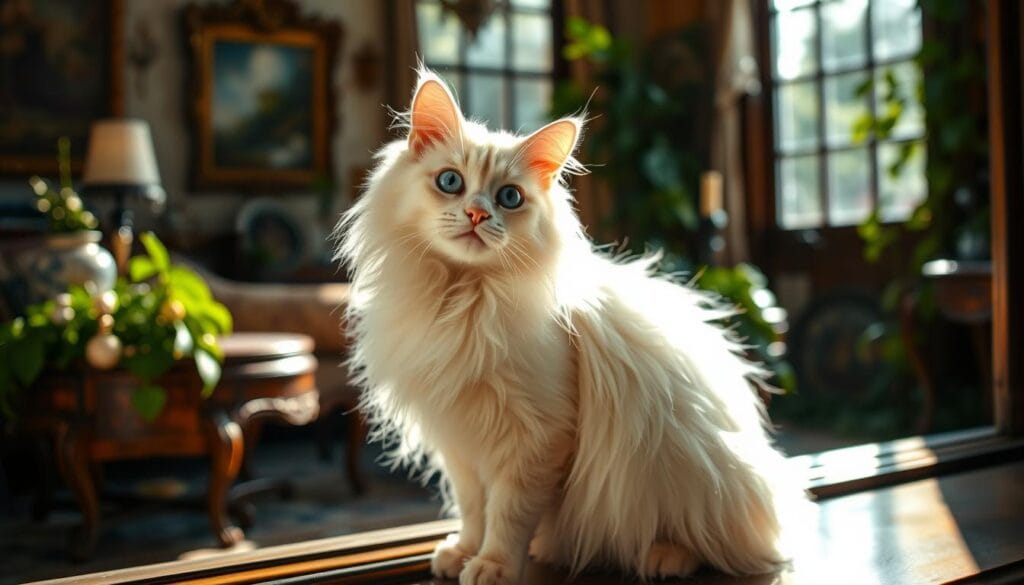
In the 20th century, conservation efforts were initiated to preserve the breed. The Ankara Zoo, along with the Atatürk Forest Farm, focused on maintaining the purity of white specimens. These efforts ensured the survival of the Turkish Angora’s unique traits.
The Cat Fanciers’ Association (CFA) officially recognized the breed in 1973, including colored variants. This recognition marked a milestone in the breed’s global popularity. However, there are genetic differences between Turkish and American-bred Angoras, which are important to note.
- Originated in 15th-century Anatolia, modern Turkey.
- Played a key role in developing other long-haired breeds.
- Conservation efforts by Ankara Zoo preserved white specimens.
- CFA recognition in 1973 for colored variants.
- Genetic differences exist between Turkish and American-bred Angoras.
Characteristics of Angora Kittens
The Turkish Angora stands out with its striking features and unique traits. From their silky coats to their expressive eyes, these cats are a visual delight. Their physical attributes make them one of the most recognizable breeds in the feline world.
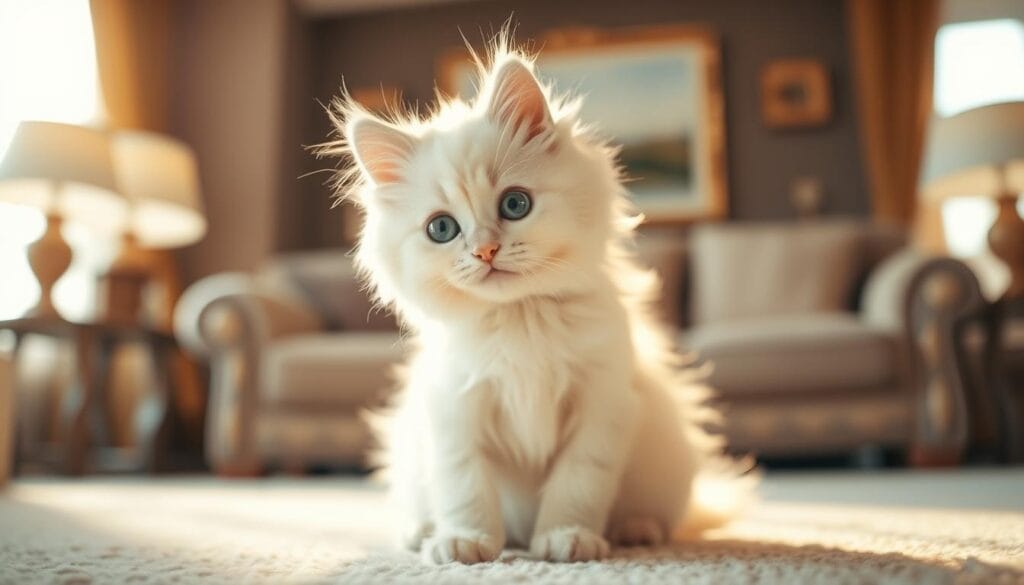
Coat Colors and Patterns
One of the most captivating aspects of the Turkish Angora is their coat. While white is the most common color, they can also appear in black, blue, red, and even tabby patterns. Their fur is lightweight and silky, requiring minimal grooming compared to other long-haired breeds.
Eye Colors and Markings
The breed’s almond-shaped eyes are a signature feature. They come in shades of blue, green, amber, or yellow. Interestingly, eye color often correlates with coat patterns. For example, white-coated cats may have blue or odd-colored eyes.
Facial markings are another standout trait, especially in non-solid-colored cats. These patterns can range from subtle stripes to bold patches, adding to their unique charm. The prized “odd-eyed” trait, where each eye is a different color, is particularly sought after in breeding programs.
When it comes to the head structure, there’s a noticeable difference between show and traditional types. Show cats often have a more refined appearance, while traditional types retain a more natural look. Both, however, exude elegance and grace.
Behavior and Temperament of Angora Kittens
Turkish Angoras are known for their unique personalities and strong bonds with their owners. These cats are not just beautiful; their behavior sets them apart from other breeds. Understanding their temperament can help you build a lasting relationship with them.

Playfulness and Intelligence
One of the standout traits of the Turkish Angora is their playful and intelligent nature. They love interactive toys and puzzles that challenge their minds. This breed thrives in environments where they can explore and engage in activities.
Their intelligence also makes them quick learners. You can teach them tricks or even train them to walk on a leash. This makes them a great choice for families who enjoy spending time with their pets.
Bonding with Humans
Turkish Angoras often form intense bonds with their owners. They tend to choose a “favorite person” in the family, showing them extra affection. This doesn’t mean they ignore others; they simply have a special connection with one individual.
These cats are also great with respectful children. They enjoy gentle play and can be a wonderful addition to a family. However, they may show jealousy toward other pets, especially if they feel their bond with their favorite person is threatened.
To strengthen your relationship, engage in interactive play sessions. Use toys like feather wands or laser pointers to keep them entertained. Their “conversational” meows and trills will let you know they’re enjoying the time together.
“Turkish Angoras are not just pets; they become a part of your family.”
| Trait | Description |
|---|---|
| Playfulness | Loves interactive toys and puzzles. |
| Intelligence | Quick learners, can be trained to perform tricks. |
| Bonding | Forms strong bonds, often choosing a favorite person. |
| Compatibility | Great with respectful children, may show jealousy toward other pets. |
| Vocalization | Uses meows and trills to communicate. |
Health Considerations for Angora Kittens
Ensuring the health of your Turkish Angora is essential for a long and happy life. This breed is generally healthy, but like all cats, they have specific health needs that require attention. Proper care can help them live a lifespan of 12 to 18 years.
Genetic Health Issues
While the Turkish Angora is a robust breed, they can be prone to certain genetic conditions. One common issue is hypertrophic cardiomyopathy (HCM), a heart disease that affects many cats. Regular cardiac ultrasounds are recommended for adult cats to monitor heart health.
Another concern is deafness, which is more common in white-coated cats with blue eyes. If your cat shows signs of hearing loss, consult your vet for a thorough evaluation. Early detection can help manage these conditions effectively.
Regular Health Check-ups
Routine vet visits are crucial for maintaining your cat’s health. Kittens should follow a vaccination schedule to protect against diseases like feline distemper and rabies. Annual check-ups are essential for adults to catch any potential issues early.
Dental care is another important aspect. Regular brushing and professional cleanings can prevent periodontal disease, which is common in cats. Additionally, grooming sessions should include skin checks to detect any abnormalities like rashes or lumps.
Nutritional Needs
Proper nutrition plays a vital role in your cat’s overall health. Kittens require high-protein diets to support their growth, while adults need balanced meals to maintain their weight. Senior cats may benefit from specialized diets that address age-related issues like joint health.
Always consult your vet to determine the best food for your Turkish Angora. Avoid overfeeding, as obesity can lead to other health problems.
| Health Aspect | Recommendation |
|---|---|
| Vaccinations | Follow a vet-approved schedule for kittens and adults. |
| Dental Care | Brush teeth regularly and schedule professional cleanings. |
| Cardiac Health | Annual ultrasounds for adult cats to monitor heart condition. |
| Nutrition | High-protein diets for kittens, balanced meals for adults. |
| Grooming | Regular skin checks during grooming sessions. |
By staying proactive about your Turkish Angora’s health, you can ensure they remain a joyful and active companion for years to come.
Caring for Your Angora Kitten
Proper care is essential to keep your Turkish Angora healthy and happy. This elegant breed requires attention to grooming, diet, and overall well-being. By following a few simple guidelines, you can ensure your cat thrives in your home.
Grooming and Coat Care
The silky coat of the Turkish Angora is one of its most striking features. Regular brushing helps prevent tangles and keeps their fur shiny. Use a soft-bristle brush or comb to gently remove loose hair.
Bathing is rarely necessary, but if needed, use a mild cat shampoo. Their fascination with water makes bath time easier than with other breeds. Always dry them thoroughly to avoid chills.
Diet and Nutrition
A balanced diet is crucial for your cat’s health. Kittens need high-protein meals to support their growth, while adults require portion-controlled feeding to prevent obesity. Puzzle feeders can add mental stimulation during mealtime.
Incorporate supplements like omega fatty acids for a healthy coat and skin. Avoid toxic foods like chocolate, onions, and grapes. Ensure fresh water is always available, as proper hydration is vital.
| Aspect | Recommendation |
|---|---|
| Feeding Schedule | Portion-controlled meals twice a day. |
| Supplements | Omega fatty acids for coat health. |
| Toxic Foods | Avoid chocolate, onions, and grapes. |
| Hydration | Provide fresh water daily. |
| Mental Stimulation | Use puzzle feeders for engagement. |
By focusing on grooming and nutrition, you can ensure your Turkish Angora remains a joyful and active companion for years to come.
Why Angora Kittens Make Great Pets
Bringing a Turkish Angora into your home can transform your daily life. These elegant cats are not only beautiful but also highly adaptable, making them ideal for various living situations. Whether you live in an apartment or a house, they thrive in environments where they can explore and bond with their family.
One of the standout features of Turkish Angoras is their compatibility with allergy sufferers. Their low-dander coats make them a great choice for those who typically struggle with pet allergies. This breed’s silky fur requires minimal grooming compared to other long-haired cats, making them easier to care for.
These cats are also known for their watchdog-like alertness. They are highly observant and will often alert you to unusual sounds or movements. This trait, combined with their affectionate nature, makes them excellent companions for both individuals and families with children.
Many Turkish Angoras have found success in therapy animal roles. Their calm demeanor and ability to form strong emotional bonds make them perfect for providing comfort and support. A Petfinder survey revealed that 94% of owners report intense emotional connections with their cats, highlighting their unique ability to enrich lives.
“Turkish Angoras are not just pets; they become a part of your family.”
When it comes to maintenance, Turkish Angoras are surprisingly low-maintenance compared to other long-haired breeds. Their lightweight coats require less frequent grooming, and their playful nature keeps them active and healthy. Below is a comparison of their care needs:
| Aspect | Turkish Angoras | Other Long-Haired Breeds |
|---|---|---|
| Grooming Frequency | Weekly brushing | Daily brushing |
| Dander Levels | Low | Moderate to High |
| Activity Level | High | Moderate |
| Compatibility with Allergies | Excellent | Variable |
| Bonding with Owners | Strong | Moderate |
With their adaptability, low-maintenance care, and loving personalities, Turkish Angoras make exceptional pets for a wide range of households. Whether you’re looking for a playful companion or a therapy animal, this breed is sure to bring joy and warmth to your home.
Conclusion
The Turkish Angora is a breed that combines elegance, intelligence, and loyalty, making it a standout choice for cat lovers. Known for their beauty and affectionate nature, these pets form deep bonds with their families. Their playful demeanor and low-maintenance grooming needs add to their appeal.
If you’re considering adding a Turkish Angora to your home, adopt from reputable breeders. This ensures you get a healthy, well-socialized kitten. Remember, owning a cat is a long-term commitment that requires time, care, and attention.
This breed is ideal for experienced cat owners who can meet their needs. For those ready to welcome a Turkish Angora, check CFA-registered breeders for trusted sources. With the right care, these pets will bring joy and companionship for years to come.
FAQ
What makes the Turkish Angora breed unique?
The Turkish Angora is known for its soft, silky coat, striking eyes, and elegant appearance. This breed is one of the oldest natural breeds, with a history dating back centuries in Turkey.
What colors and patterns are common in Angora cats?
Turkish Angoras come in a variety of coat colors and patterns, including solid, tabby, and bi-color. White is the most iconic, but they can also have black, blue, red, or cream coats.
Are Angora kittens playful and intelligent?
Yes, these cats are highly playful and intelligent. They enjoy interactive toys, puzzles, and bonding with their human family through games and activities.
How do Turkish Angoras bond with their owners?
This breed is affectionate and forms strong bonds with their owners. They thrive on attention and often follow their family members around the house.
What health issues should I watch for in Angora kittens?
While generally healthy, Turkish Angoras can be prone to genetic conditions like hypertrophic cardiomyopathy. Regular vet check-ups are essential to monitor their health.
How often should I groom my Angora kitten?
Despite their long coat, Turkish Angoras require minimal grooming. Brush them weekly to prevent tangles and keep their fur smooth and shiny.
What should I feed my Angora kitten?
Provide a balanced diet rich in protein and essential nutrients. High-quality cat food, whether wet or dry, will support their growth and energy needs.
Are Turkish Angoras good with children and other pets?
Yes, they are known for their gentle and adaptable nature. They get along well with children and can coexist peacefully with other pets when introduced properly.



